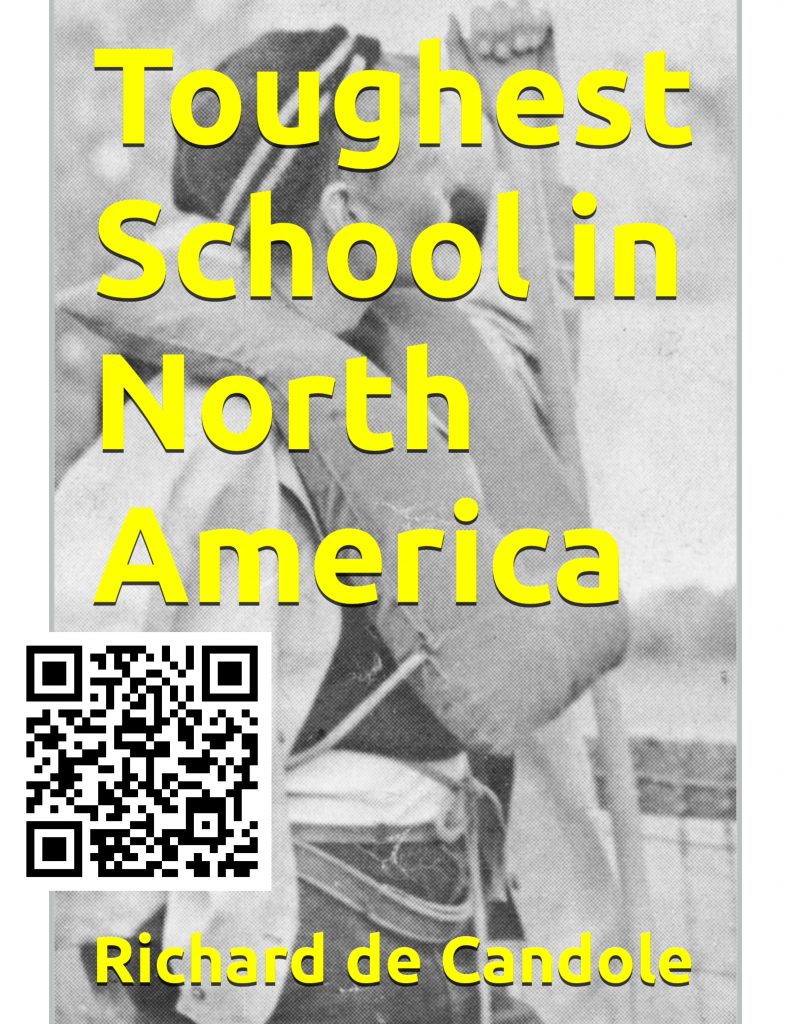
The snap of a dry stick under John Robertson’s foot shattered the stillness of the night. Instantly he froze, as did the boys following him.
There were no lights on in the Doolan house but Robertson could see through the screen that the back door was not closed. Was someone still awake or had they left the door open to cool the house down? It had been an unusually hot June day. It was late but still, he sensed danger.
“Let’s get out of here,” he said in a loud whisper. In a flash, they were by the end of the white bungalow, had cut across a small field, and were racing down the road towards Selkirk. They practically reached the first bend before finally stopping to catch a breath.
“You idiot, Robertson,” chided Michael Davies. “Why did you go so close to the house? Didn’t you see Doolan standing in the kitchen?”
“Piss off. How was I supposed to know? Their lights were all off,” replied Robertson.
“Well now we’re screwed,” complained Mike Byfield, half winded, half-wild from the adrenalin surging through his body.
“He’ll probably do a bed check and then come after us. Now that we’re out we might as well keep going. We can hit the ditch if we hear a car come.”
And so they went, running down the road like convicts on a jailbreak. What started out as an always risky middle-of-the-night walk to Selkirk to buy cigarettes had turned into a cat and mouse game they knew they could lose.
Smoking carried a heavy penalty – an automatic “10 of the best” usually administered by Mr. Wiens. Anyone who smoked had two basic concerns – finding a place to smoke and finding a way to maintain their supply.
Smoking was a clandestine pursuit which fall, spring, and summer went mostly undetected. After all, behind the school were 360 acres of bush in which to disappear.
It was never an offense to be out walking in the bush and masters seldom tried to catch students in the act. Only if they didn’t take care to cover up the smell upon return to the school did they get into trouble.
During the winter months, smokers had to be considerably bolder. They would need to find locations inside that were out of the way and less frequented by masters. Both the third floor of the stone building and the staff house basement were fairly safe during the duty period because there were legitimate reasons for being there. However, they were not so good at recess or just before bed.
Probably the best location was third-floor fire escape door on the east side. It opened onto the roof of the adjoining building creating a cozy alcove. Masters almost never went up to the third floor at unpredictable times.
The other favorite smoker’s den was the barn. Getting caught in the barn, however, was really playing with fire, to pardon the pun. It put the offender in double jeopardy. Nothing was feared more by staff than a barn fire. Smoking there was viewed as a double offense and always resulted in extra swats. Mr. Bennett once caught Dan Raymes and Craig Stephens smoking in the barn after lights out – a triple offence – and gave them 20 swats each, breaking a stretcher in the process, such was his anger.
Occasionally, smokers would light up in the dorm after lights out but it was less convenient because it usually meant having to wait at least an hour until after the duty master had stopped patrolling the halls.
Buying cigarettes was a major challenge on any day except Sunday when there was a store break in Winnipeg after the evening church service. During the snowshoe season, there was usually a mid-week opportunity because practices included a store break. And on free weekends it was also permitted to snowshoe to Clandeboye on Saturday afternoon on the pretext of doing extra training.
The rest of the year the smoker had to be considerably more creative because there was never an excuse for being off the property. One option was to sneak into Selkirk after lights out because the bus depot cafe was open until midnight.
Frank Doolan and his wife Jean arrived at the school with their four daughters and three sons in 1964. He was an electronics technician who came to help beef up the science program. He brought with him one major handicap – he was considerably overweight. It meant the school’s outdoor program was a constant struggle.
Mr. Doolan had one other weakness that proved near-fatal when it came to discipline. Whenever he tried to get tough, he always sounded like he was going to cry. His “Come on, you guys” reprimands were high-pitched, never-feared, and often-mimicked.
When things really got nasty, such as the time he fell off the stern during the overnight St. Adolphe canoe race, along with the howls of laughter, there was some reluctance to even go back and get him. As punishment, he made the crew paddle the rest of the night in silence. The next morning he called on Mr. Byfield to denounce their disrespectful behavior.
The one area he was respected was in the radio room. Because of his expertise and enthusiasm, it was the only club that had regular members, month after month. He could also be soft-hearted and would sometimes give you a break. Like he did the night Davies, Byfield, and Robertson snuck into Selkirk.
They had only been on the road a short time when a beam of light sprang up behind them. At first, they didn’t respond to the danger. A kind of fearless euphoria had taken hold. It seemed too soon for Mr. Doolan to be on the road. By the time they did react it was too late.
Moments after flinging themselves into the ditch the car stopped less than 50 feet away. Someone got out and started walking towards them, flashlight in hand, searching either side of the road. It could only be Mr. Doolan.
By some miracle, when he was about 10 feet away, he made one very brief pass with the light over where they lay and then crossed to the other side.
They couldn’t believe their luck. Their hearts were still racing when they heard him get back in the car. They had only one remaining fear: would he move the car forward and start searching where he left off? Luck was with them again as he drove past and then stopped.
They waited until he had finished his second search before making a move. Down the bank, they scrambled to the edge of the river 20 feet below.
With detection once back at the school now a certainty they felt like real fugitives. They dashed along the river’s edge, more determined than ever to succeed.
They stayed away from the road all the way into town, spent no longer at the bus depot than it took to buy cigarettes, and then they left. The return journey was an hour of indescribable exhilaration and camaraderie as they puffed on cigarettes and laughed about their narrow escape.
The trip ended with them dreaming up fanciful scenarios of how the confrontation would unfold. At one point they had Mr. Doolan on his knees begging them to confess. They hoped to get it over with that night while they were still flying high. Fifty swats would have felt like five at that moment.
After stashing their cigarettes outside the school, they walked into the dorm like it was the middle of the afternoon. They were in bed and under the covers when they heard the door open and someone walk down the hall, flashlight in hand, shining it in each cubicle.
Nothing was said then or the next day. They were certain Mr. Doolan had figured out their identity, but they couldn’t be sure. The annual canoe trips had begun and many of the beds were now empty.
Richard de Candole has been working in British Columbia and Alberta as a reporter and editor for over 40 years. Toughest School in North America is about his five years as a student at St. John’s Cathedral Boys’ School in Selkirk, Manitoba from 1962 to 1968. Richard lives with his wife Wendy in Qualicum Beach, British Columbia.
Buy the book exclusively through Amazon.


